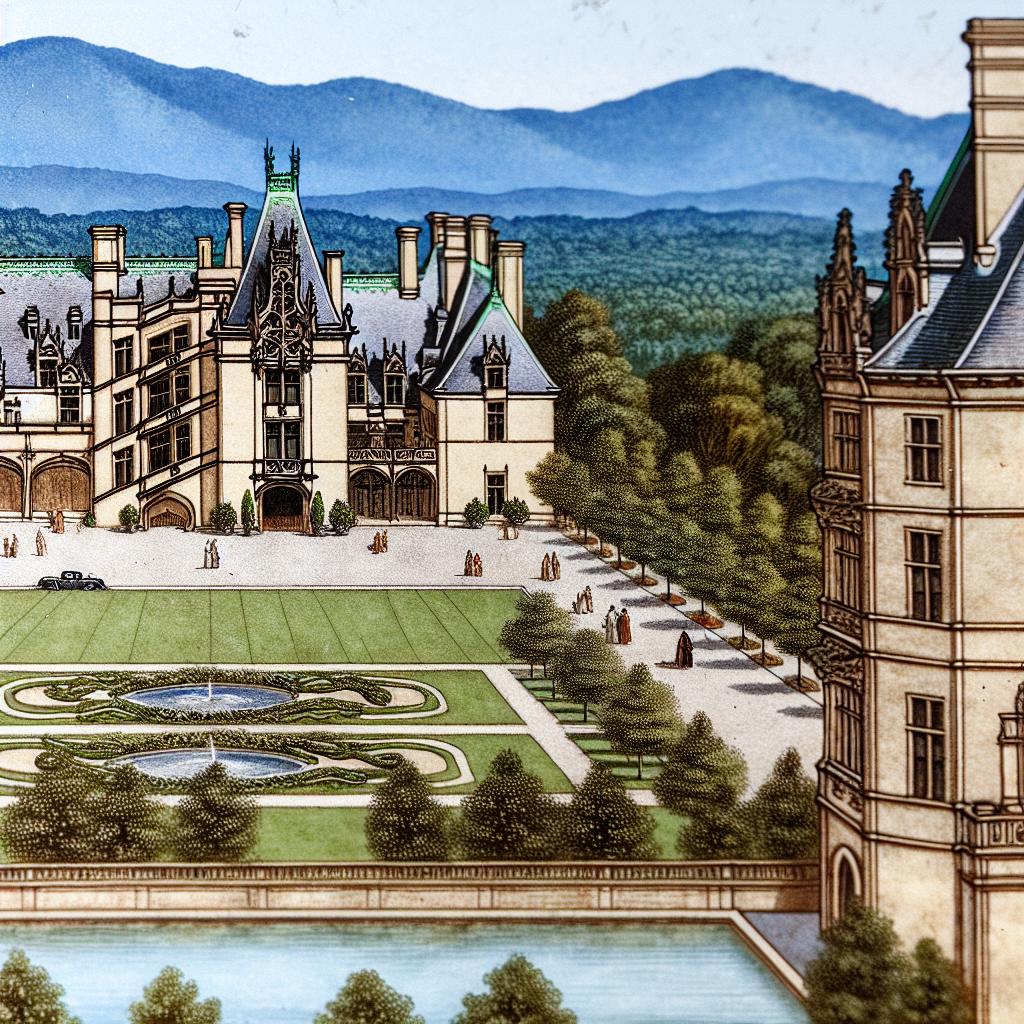Contents
The Origins of Biltmore Estate
Nestled in the Blue Ridge Mountains of Asheville, North Carolina, the Biltmore Estate stands as a quintessential example of Gilded Age opulence and American architectural innovation. Constructed between 1889 and 1895, the estate was commissioned by George Washington Vanderbilt II. Inspired by his family’s wealth and influence, Vanderbilt envisioned creating a country retreat reminiscent of European chateaus.
The design of the Biltmore Estate was the brainchild of renowned architect Richard Morris Hunt, who modeled it after French Renaissance chateaus, specifically the Château de Blois and Château de Chambord in France. Landscape architect Frederick Law Olmsted, best known for designing New York City’s Central Park, was responsible for the estate’s sprawling grounds and gardens.
Architectural Marvel
The Biltmore House is a testament to painstaking craftsmanship and meticulous attention to detail. Covering approximately 175,000 square feet, it is the largest privately-owned home in the United States. The mansion comprises 250 rooms, including 35 bedrooms, 43 bathrooms, and 65 fireplaces. Notable features include a banquet hall with a 70-foot ceiling, an indoor swimming pool, and a bowling alley.
The estate’s architectural complexity extends beyond its size and features. Designed at a time when the Beaux-Arts architectural style was in vogue, Hunt’s work on the Biltmore balanced grandeur with elements of functionality. **Intricate stonework, expansive staircases, and fine details in wood and glasswork** mark the exquisite craftsmanship of the era. The entire composition of the estate, both the interiors and exteriors, reflects the luxurious sensibilities of the late 19th century.
Innovative Features
The estate’s technological advancements were groundbreaking at the time of its construction. Biltmore was equipped with electricity from inception, thanks to a power plant built on the property. The house also featured a state-of-the-art heating system and an elevator, which were significant technological luxuries in the late 19th century.
The innovations did not stop with heating and electricity. The estate’s plumbing systems were sophisticated, featuring a network of pipes that supplied water throughout the house. The indoor pool, for instance, was heated, which was a remarkable feat for its time. Additionally, the Biltmore included refrigeration systems that marked a shift from traditional cooling methods to more modern, efficient techniques, ensuring the estate remained at the cutting edge of comfort and convenience.
The Vanderbilt Legacy
George Vanderbilt’s legacy extends beyond the architectural grandeur of the estate. His interests in art, literature, and agriculture shaped the future direction of the Biltmore. The estate’s library houses an impressive collection of over 22,000 volumes, highlighting Vanderbilt’s passion for literature.
Vanderbilt’s commitment to cultural and intellectual pursuits resonated throughout the estate. The vast collection of art and artifacts displayed across the rooms provided visitors an insight into the rich tapestry of global art traditions. Paintings from European masters, exquisite tapestries, and rare furnishings added layers of aesthetic sophistication to the Biltmore, reflecting Vanderbilt’s discerning taste and foresight in curating an environment that celebrated creativity and knowledge.
Agriculture and Sustainability
The Biltmore Estate played a pivotal role in advancing sustainable agriculture and forestry practices. George Vanderbilt and his successors implemented progressive farming techniques and maintained a scientific approach to land management. The estate’s success in sustainable forestry was evident in the early 20th century when Biltmore hosted the first forestry school in the United States, now part of the National Park Service.
The dedication to sustainability extended to preserving the estate’s ecology. **Olmsted’s landscape architecture was not merely about aesthetics; it was a conscious effort to harmonize human living spaces with nature**. These practices encouraged biodiversity and ecological balance, ensuring that the Biltmore remained a verdant oasis that could be both lived in and preserved for future generations.
Modern-Day Preservation
Today, the Biltmore Estate remains a privately-owned property, yet it has adapted to become a significant tourist attraction, drawing more than a million visitors annually. The estate operates as a self-sustaining enterprise with diverse offerings, including tours, accommodations, and extensive gardens.
Efforts to maintain the estate’s grandeur involve a continuous series of restoration and preservation projects. Specialists in historic preservation engage in meticulously restoring paintings, fabrics, furniture, and architectural features. The estate’s immense gardens and landscapes are continually curated, ensuring they retain the elegant designs originally envisioned by Olmsted.
Cultural Impact
The estate has also contributed significantly to the cultural fabric of the region. By hosting various exhibitions and events, it continues to serve as a site of educational and cultural exchange. The preservation of the estate ensures the enduring legacy of the Vanderbilt family’s contributions to architecture, agriculture, and conservation.
From seasonal celebrations to specialized tours that delve into the estate’s history and design, the Biltmore actively participates in enriching local and visitor appreciation of cultural heritage. Such activities not only underscore the estate’s role as a cultural steward but also integrate modern narratives and innovations in preserving and celebrating history.
Future Plans
Future plans for the Biltmore involve ongoing restoration projects and enhancements aimed at preserving its historical authenticity while accommodating modern conveniences. These efforts ensure that the Biltmore will continue to inspire and educate future generations about the rich history of the Gilded Age and the foresight of its creators.
Plans also include the potential expansion of educational programs that engage younger audiences. Introducing new technologies in tour experiences, such as augmented reality, offers interactive ways for visitors to experience the grandeur and history of Biltmore. These initiatives ensure that the estate not only survives but thrives, finding new ways to resonate with audiences far removed from its original era.
The Biltmore Estate’s history is a narrative of ingenuity, artistic vision, and harmonious coexistence with nature. It invites reflection on a past that blends seamlessly into the current day, maintaining a presence that is as relevant now as it was over a century ago. Through ongoing preservation and dynamic integration into contemporary cultural and environmental conversations, the Biltmore secures its place as an architectural marvel and a beacon of sustainable heritage.

